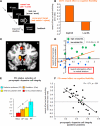Striatal Dopamine and the Interface between Motivation and Cognition
- PMID: 21808629
- PMCID: PMC3139101
- DOI: 10.3389/fpsyg.2011.00163
Striatal Dopamine and the Interface between Motivation and Cognition
Abstract
Brain dopamine has long been known to be implicated in the domains of appetitive motivation and cognition. Recent work indicates that dopamine also plays a role in the interaction between appetitive motivation and cognition. Here we review this work. Animal work has revealed an arrangement of spiraling connections between the midbrain and the striatum that subserves a mechanism by which dopamine can direct information flow from ventromedial to more dorsal regions in the striatum. In line with current knowledge about dopamine's effects on cognition, we hypothesize that these striato-nigro-striatal connections provide the basis for functionally specific effects of appetitive motivation on cognition. One implication of this hypothesis is that appetitive motivation can induce cognitive improvement or impairment depending on task demands.
Keywords: Parkinson's disease; cognition; dopamine; flexibility; motivation; prefrontal cortex; reward; striatum.
Figures



Similar articles
-
The place of dopamine in the cortico-basal ganglia circuit.Neuroscience. 2014 Dec 12;282:248-57. doi: 10.1016/j.neuroscience.2014.10.008. Epub 2014 Oct 19. Neuroscience. 2014. PMID: 25445194 Free PMC article. Review.
-
Striatal dopamine mediates the interface between motivational and cognitive control in humans: evidence from genetic imaging.Neuropsychopharmacology. 2010 Aug;35(9):1943-51. doi: 10.1038/npp.2010.68. Epub 2010 May 12. Neuropsychopharmacology. 2010. PMID: 20463658 Free PMC article.
-
Dopamine and the motivation of cognitive control.Handb Clin Neurol. 2019;163:123-143. doi: 10.1016/B978-0-12-804281-6.00007-0. Handb Clin Neurol. 2019. PMID: 31590726 Review.
-
Dopamine and the cognitive downside of a promised bonus.Psychol Sci. 2014 Apr;25(4):1003-9. doi: 10.1177/0956797613517240. Epub 2014 Feb 13. Psychol Sci. 2014. PMID: 24525265 Free PMC article.
-
Involvement of basal ganglia and orbitofrontal cortex in goal-directed behavior.Prog Brain Res. 2000;126:193-215. doi: 10.1016/S0079-6123(00)26015-9. Prog Brain Res. 2000. PMID: 11105648 Review.
Cited by
-
Diminished appetitive startle modulation following targeted inhibition of prefrontal cortex.Sci Rep. 2015 Mar 10;5:8954. doi: 10.1038/srep08954. Sci Rep. 2015. PMID: 25752944 Free PMC article.
-
Domain-general cognitive motivation: Evidence from economic decision-making - Final Registered Report.Cogn Res Princ Implic. 2022 Mar 18;7(1):23. doi: 10.1186/s41235-022-00363-z. Cogn Res Princ Implic. 2022. PMID: 35301624 Free PMC article.
-
Network-level assessment of reward-related activation in patients with ADHD and healthy individuals.Hum Brain Mapp. 2017 May;38(5):2359-2369. doi: 10.1002/hbm.23522. Epub 2017 Feb 8. Hum Brain Mapp. 2017. PMID: 28176434 Free PMC article.
-
Transcriptome-based analysis of blood samples reveals elevation of DNA damage response, neutrophil degranulation, cancer and neurodegenerative pathways in Plasmodium falciparum patients.Malar J. 2021 Sep 26;20(1):383. doi: 10.1186/s12936-021-03918-5. Malar J. 2021. PMID: 34565410 Free PMC article.
-
Reward Contingencies Improve Goal-Directed Behavior by Enhancing Posterior Brain Attentional Regions and Increasing Corticostriatal Connectivity in Cocaine Addicts.PLoS One. 2016 Dec 1;11(12):e0167400. doi: 10.1371/journal.pone.0167400. eCollection 2016. PLoS One. 2016. PMID: 27907134 Free PMC article.
References
LinkOut - more resources
Full Text Sources
Other Literature Sources

